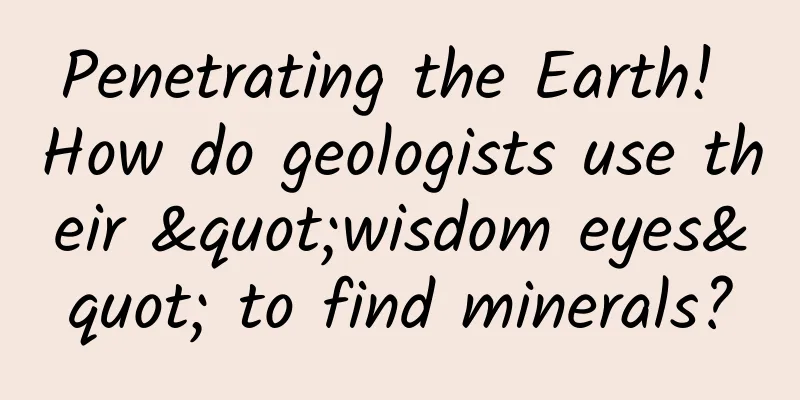Penetrating the Earth! How do geologists use their "wisdom eyes" to find minerals?

|
On June 21, 2024, Gao Jianwei, senior engineer of the Natural Resources Physical Geological Data Center of the China Geological Survey, gave a speech entitled "Studying geology means living in the mountains?" at the "It's time to serve the country with science" theme session of the Science Popularization China Starry Sky Forum. The following is an excerpt from Gao Jianwei’s speech: Geology has two main tasks. The first is to meet the needs of human survival and development, and the second is to explore the unknown of human beings. Let's talk about satisfying human development first. There are several things that need to be done: The second thing is to guide urban construction , because before urban construction, we need to conduct urban geological surveys, including foundation stability, hydrogeology, underground space, etc. The third aspect is to resist natural disasters . Because we humans will face many natural disasters, including earthquakes, volcanoes, landslides, mudslides, etc., we need to investigate the formation laws of these geological disasters and further guide everyone on how to avoid or resist these natural disasters. The fourth aspect is to study the geological environment, which can protect human health . The geological environment is divided into two aspects: one is the pollution control of the geological environment, and the other is the geological health problem. Some places will produce some endemic diseases, which are often related to the abundance or scarcity of certain elements in the local rocks or soil. For example, Keshan disease is caused by the very low selenium content in the local soil. How to use mineralization laws to find minerals? Traditional geology has several research areas. The first is to study the material composition of our earth, mainly studying stones. From a geological perspective, stones can be divided into three major categories: minerals, rocks, and ores. Everyone may have seen minerals. For example, common quartz can become black crystal, amethyst or even more beautiful gemstone if it has color; rocks are mainly granite, limestone, dolomite, conglomerate, sandstone, etc. Among them, there is a special kind of rock called a mine, which is when some useful elements are enriched to a certain extent, they become ores, and when the ores are further enriched, they become mineral deposits. After the mineral deposits are developed, people can use these useful elements. Among the several branches of geology, crystallography and mineralogy mainly study minerals, petrology mainly studies rocks, and ore deposits and mineral exploration mainly study ore deposits. At the same time, these disciplines are not separated from each other, but are inextricably linked to each other. For example, this photo shows a gold mine in the northern waters of Jiaodong. It looks spectacular. This is an altered rock type gold mine. Deep in the earth, there are many gold-bearing fluids. As they migrate to the shallower parts, as the temperature drops, these gold-bearing fluids gradually form some pyrites, which are gold-bearing minerals. Gold is hidden in these pyrites. If the pyrites are enriched enough, it becomes a gold mine. Through research, we found an interesting phenomenon: in addition to the main elements of iron and sulfur, these pyrites also contain a large number of trace elements. As the temperature decreases, the head and shallow part of the ore deposit will contain low-temperature trace elements such as arsenic and antimony, while when the tail of the ore body is hot, high-temperature trace elements such as cobalt and nickel will be fully developed. Therefore, we used this mineralization law to conduct a comprehensive survey of gold mines in the northern waters of Sanshan Island. It was found that among the pyrite samples collected from these ore bodies more than 1,000 meters underground, 70 to 80 percent of the trace elements were low-temperature trace elements. This gives us sufficient reason to believe that there should be a lot of room for prospecting more than 1,000 meters below the surface, and it also gives local mining companies great confidence - this is a job that we geologists have to do, which is to guide prospecting, and it is also a very meaningful job. How to use geophysics to find minerals? The second research area of traditional geology is to study the internal structure and structure of the earth. In order to understand the structure of the earth, a discipline called geophysics emerged. Later, in order to understand the structures of rock development, structural geology was created. Simply put, geophysics is the use of geophysical methods to explore the structure of the earth's interior, including various anomalies. Its main methods include gravity, magnetism, electricity, earthquakes, etc. For example, geologists can use earthquakes to study the structure of the earth. By receiving the seismic wave speeds of some large earthquakes on the earth, geologists divide the earth into three layers: crust, mantle and core. Later, geologists proposed that the interior of the earth is not entirely rigid, not all rock, but there is a layer of asthenosphere in the upper mantle, which is a bit similar to the dumpling soup we eat. It is a asthenosphere that can flow but is not entirely liquid. At the same time, geophysics can also be used to find minerals. For example, if there is an iron mine several hundred meters underground, its useful mineral may be magnetite. Because magnetite has strong magnetism, geophysicists can use magnetometers to detect magnetic anomalies deep underground. Then, by discovering this anomaly, they can infer that there may be a large iron mine underground. How to use structural geology to find minerals? There are various structural deformations on the earth, such as faults, folds, cleavages, etc. What are their combinations? What are the conditions for their formation? These are the questions that structural geology needs to find out. Moreover, studying the earth's structure is also very meaningful for prospecting. Why? Because many large and super-large deposits are controlled by structure. Let's take another example of our gold mine exploration in the Jiaodong region. This picture is the Linglong Gold Mine in Zhaoyuan, Shandong, which is a gold mine with a very long history. There are a lot of granite here, and a lot of cracks and faults have developed in the granite. Many gold-bearing quartz veins have been sunk in the cracks, and pyrite has developed in the quartz veins, which contain a lot of gold. Through the study of the structure, we found another very interesting phenomenon: before the formation of the ore body, these cracks were subjected to a compressive stress, because the structure must be subjected to force. When it began to be subjected to compressive stress, the fault was formed, and it was tightly closed, so it was said that it did not form minerals at that time; during the mineralization period, it was subjected to a stretching force, the fault opened, and cracks were formed underground. After that, the hot fluid containing gold in the deep moved into these cracks. Suddenly entering the cracks, these hot fluids will reduce pressure, and the decompression will boil, and after boiling, they will be enriched to form ore bodies. Therefore, a careful study of the structure can also help us gain a deeper and more thorough understanding of the mineral deposits. Planning and production Author: Gao Jianwei, Senior Engineer of Natural Resources Physical Geological Data Center of China Geological Survey Editor: Yang Yang Proofread by Xu Lailinlin |
<<: Is there someone else who is the “culprit” of methane production?
>>: These 3 types of people are really not suitable for naps! Check if it’s you
Recommend
How does our brain make us sleepy?
Have you ever thought about this question: Why do...
I was just cooking, and my life was gone in an instant! 8 deadly behaviors in the kitchen, never do them!
The kitchen is the busiest place in the house, an...
Product Operation: How to build a business architecture from 0 to 1?
Based on his own thoughts and ideas from project ...
Shuangyashan SEO training: How can enterprise SEO improve website page inclusion?
For webmasters, how to improve the website's ...
rua Can I pet a tiger if I'm allergic to cats? Tiger: Are you polite?
What is it like to encounter a tiger just when yo...
Magic Leap's core technology revealed
This article is reproduced from the WeChat public...
Fireflies are in their best viewing season! It turns out that they glow not only for courtship...
In the hot summer, it is the time of the year whe...
How to do KOL marketing promotion? 4000 words of dry goods presented
With the rise of short video platforms such as Ti...
Shapers of Earth's history: Are meteorites "destroyers" or "midwives"?
Tuchong Creative In the long history of the Earth...
A few key points about digital advertising!
In my early years, I worked for the largest Inter...
Smallpox eradication day: How difficult it is to defeat disease? Just look at the 200-year history of human struggle with smallpox.
On October 25, 1979, the World Health Organizatio...
Hongmeng Ecosystem Enters Second Phase, Accelerating Hongmeng Application in Thousands of Industries
[Shenzhen, China, January 18, 2024 ] Today , Huaw...
How to write copy to attract consumers?
When we shop online, we often see comparison pict...
iOS 18 upgrade experience, there’s something new!
Yesterday, Apple released the new iOS 18 system, ...
Lin Qiaozhi's 120th birthday: The lifelong unmarried "mother of ten thousand babies"
Today marks the 120th birthday of Dr. Lin Qiaozhi...









